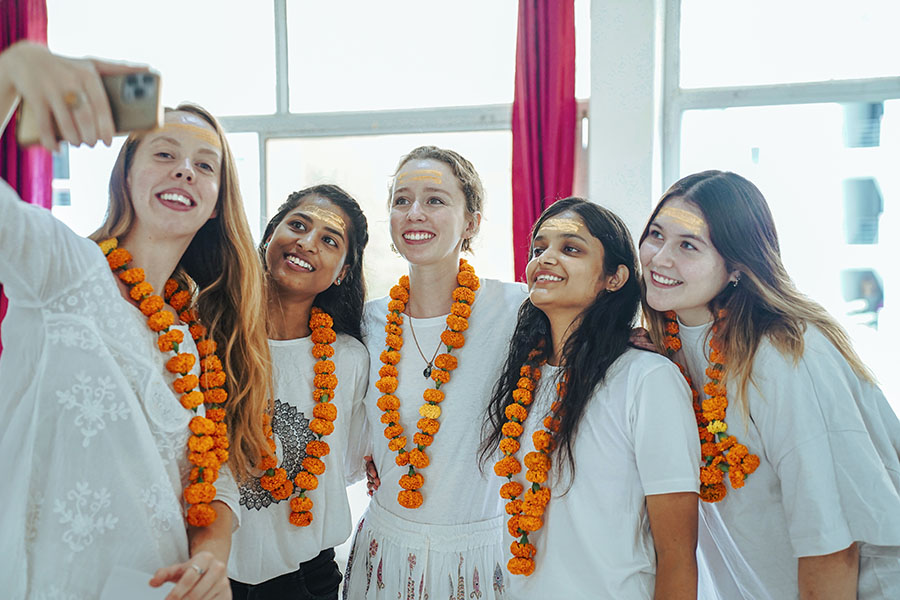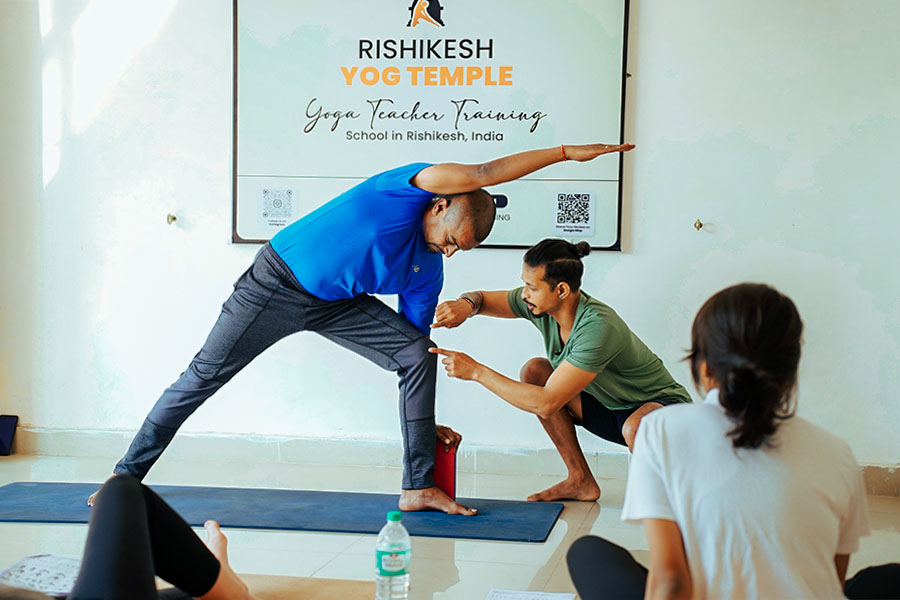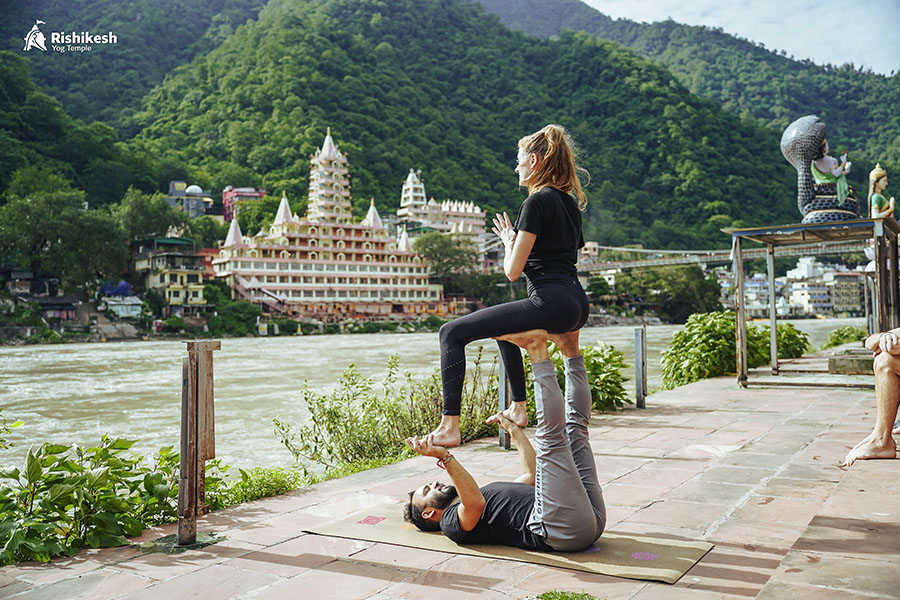Duration: 25 Days
Home » Yoga Blog » Downward Facing Dog

A Complete Guide to Downward Facing Dog Pose: Benefits, Variations, and Precautions
Downward Facing Dog, also known as Adho Mukha Svanasana in Sanskrit, is one of the most popular yoga poses in the Western world. It is a foundational pose that is often used in yoga sequences, and it offers numerous benefits for both the mind and body.
Benefits of practicing Downward Facing Dog (Adho Mukha Svanasana)
- Strengthens and stretches the muscles: This pose helps to strengthen the arms, shoulders, legs, and core, while also stretching the hamstrings, calves, and spine.
- Improves circulation: The inverted nature of the pose can help to improve circulation throughout the body.
- Calms the mind: Downward Facing Dog can help to calm the mind and reduce stress and anxiety.
- Relieves tension: This pose can also help to relieve tension in the back, neck, and shoulders.
In this blog post, we will explore the benefits of Downward Facing Dog in more detail and explain how to do the pose correctly. We will also offer modifications and variations to help you make the pose more accessible or challenging, depending on your level of experience. Additionally, we will provide tips for incorporating Downward Facing Dog into your yoga practice and suggest other poses that can be paired with it for a well-rounded practice.
How to do Downward Facing Dog:
- Begin on your hands and knees in a tabletop position with your wrists directly under your shoulders and your knees directly under your hips.
- Tuck your toes under and lift your hips up and back, straightening your arms and legs.
- Keep your hands shoulder-width apart and your feet hip-width apart.
- Press your hands firmly into the mat and distribute your weight evenly between your hands and feet.
- Engage your core and lengthen your spine.
- Draw your shoulder blades down your back and away from your ears.
- Relax your head and neck, looking down at your feet or towards your navel.
- Hold the pose for 5-10 breaths, then release by lowering your knees to the mat.
Tips for modifying the pose:
- If you have tight hamstrings or low back pain, you can bend your knees slightly.
- If you have wrist pain, you can use yoga blocks under your hands to relieve pressure.
- If you have shoulder pain, you can widen your hands or use a strap to bring your hands closer together.
Common mistakes to avoid:
- Dropping your shoulders or collapsing your chest.
- Overarching your low back or hyperextending your elbows.
- Letting your head hang or tensing your neck.
Benefits of Downward Facing Dog:
Physical benefits
- Stretches the hamstrings, calves, and spine: Downward Facing Dog provides a deep stretch for the backs of the legs and the spine, helping to relieve tension and improve flexibility.
- Strengthens the arms, shoulders, and core: Holding the pose requires strength and stability in the upper body and core, helping to tone and build muscle.
- Improves circulation: The inverted nature of the pose can help to increase blood flow to the brain and throughout the body, improving overall circulation.
- Relieves back pain: Practicing Downward Facing Dog can help to relieve tension and pain in the back, especially the lower back.
Mental benefits
- Calms the mind: Downward Facing Dog is an inversion pose, which can help to calm the mind and reduce stress and anxiety.
- Increases focus and concentration: Holding the pose requires concentration and focus, which can help to improve mental clarity and awareness.
- Promotes relaxation: The pose can help to release tension and promote relaxation in the body and mind.
Several studies have explored the benefits of yoga, including Downward Facing Dog, for physical and mental health. One study published in the International Journal of Yoga found that practicing yoga can improve flexibility, strength, and balance, as well as reduce stress and anxiety. Another study published in the Journal of Bodywork and Movement Therapies found that practicing yoga, including Downward Facing Dog, can help to relieve back pain and improve posture.
Precautions and Contraindications:
Wrist injuries: Downward Facing Dog requires significant weight-bearing on the hands and wrists. Practitioners with wrist injuries or pain should use modifications to decrease the pressure on their wrists, such as using blocks or practicing on their forearms instead.
High blood pressure: The inverted nature of the pose can increase blood pressure in some individuals. Practitioners with high blood pressure should consult with their healthcare provider before practicing Downward Facing Dog.
Pregnancy: Pregnant individuals should avoid practicing the pose after the first trimester. Modifications can be used to make the pose safe for prenatal practitioners, such as using a chair or practicing against a wall.
Variations and Modifications:
- Blocks: Practitioners can place blocks under their hands to decrease the pressure on their wrists and help with stability.
- Forearm variation: Practitioners can come into Downward Facing Dog on their forearms instead of their hands, decreasing the pressure on their wrists.
- Wall variation: Practitioners can practice the pose against a wall to help with alignment and stability.
- Chair variation: Practitioners can use a chair to practice a modified version of the pose, placing their hands on the seat of the chair and stepping back into the pose.
Incorporating Downward Facing Dog into Your Practice:
- Using Downward Facing Dog in a sequence: Downward Facing Dog is often used as a transitional pose in yoga sequences. It can be used to transition between standing poses, to lengthen and warm up the spine, or as a pose in its own right. Practitioners can incorporate Downward Facing Dog into their practice by adding it to their regular yoga sequences.
- Variations and modifications: There are many variations and modifications of Downward Facing Dog that can help practitioners deepen their practice and make the pose more comfortable and accessible. Some variations include walking the feet closer to the hands to deepen the stretch in the hamstrings, lifting one leg to practice Downward Facing Dog split, or practicing the pose with the hands on a block for greater stability. Practitioners can experiment with these variations to find the ones that work best for their body.
- Tips for making the pose more comfortable: Practitioners can use props such as blocks or blankets to make the pose more comfortable and enjoyable. Placing a blanket under the heels can help practitioners with tight calves or hamstrings, while using blocks under the hands can help with wrist pain or discomfort. Practitioners can also play with the placement of their hands and feet to find the most comfortable and stable alignment for their body.
Conclusion
In conclusion, Downward Facing Dog is a foundational yoga pose that offers numerous benefits for the body and mind. Practicing this pose regularly can help increase flexibility, strength, and mental clarity. It can be used in a variety of yoga sequences and modified to make it more accessible and comfortable for different bodies. Remember to approach the pose mindfully, paying attention to your body's sensations and making modifications as needed. By incorporating Downward Facing Dog into your yoga practice, you can experience the many benefits it has to offer.
If you're new to yoga or would like to deepen your practice, consider taking a class at a local studio or trying an online yoga class. This will allow you to learn from experienced instructors and connect with a supportive community of fellow yogis.
We hope this blog post has inspired you to try Downward Facing Dog and explore its many variations and benefits. As always, remember to listen to your body and enjoy the journey of your yoga practice.



